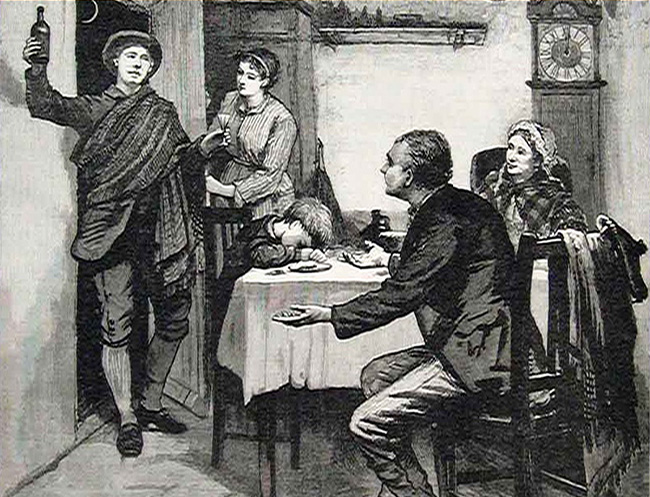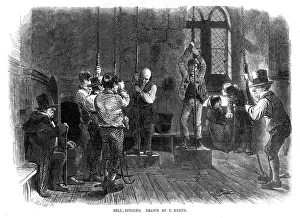
As what you do on the first day of the year determines the rest of the year, or so it is said, I was invited to speak on local radio about New Year Day customs – prominent in these is First Footing and I was interested to hear both the newsreader and the presenter recounted their own First footing.
First footing is an interesting piece of British folklore and one that is clearly spreading and as it has taking away local variants no doubt. Early accounts record that it was restricted to the north of England and Scotland but clearly has spread in the first place as the 1st of January was accepted in England as the first day of the year and as media has recorded it.
Indeed the earlier accounts record it as a Scottish custom as noted by Chamber’s 1856 Book of Days :
“There was in Scotland a first footing independent of the hot pint. It was a time for some youthful friend of the family to steal to the door, in the hope of meeting there the young maiden of his fancy, and obtaining the privilege of a kiss, as her first-foot. Great was the disappointment on his part, and great the joking among the family, if through accident or plan, some half-withered aunt or ancient grand-dame came to receive him instead of the blooming Jenny.”
A dark night?
Who should be the first footer was always important but there appears to have been virtually countrywide agreement. For example the standard description for the first footer is described in Lancashire:
“a light-haired man is as unlucky as a woman, and it became a custom for dark-haired males to hire themselves out to “take the New Year in.””
Paying someone to do it was not unusual and Maureen Sutton in her 1996 Lincolnshire calendar records an account from the city of Lincoln which recalls:
“We believed the first dark haired man to set foot over your threshold would bring with him good luck. He had also to bring in the silver, the coal, and the wood that you had put out the night before. My mother used to pay one of our neighbours to first foot she wanted to make sure that everything was done as it should be. Some women thought that first dark haired you saw on New Year’s day you would marry. A fair haired man would bring bad luck, a ginger one was even worse and a women was out of the question. I think she paid the neighbour a shilling.”
Christine Hole’s Traditions and Customs of Cheshire in 1936 records that:
“To avoid the risk of such disastrous visits. The master of the house, if he is dark, usually goes out just before midnight. As the clock strikes, he is admitted as First foot.”
In Northumbria according to Fran and Geoff Doel in 2009 Folklore of Northumbria it was also desirable that they be unmarried, possibly recalling another tradition of marrying the first man on the new day. However in Yorkshire although it was important that the First footer:
“always be a male who enters the house first, but his fairness is no objection.”
Tony Dean and Tony Shaw in their Folklore of Cornwall 2009 stressed how the presence of a man was important:
“A female must never be the first over the threshold on New Year’s Day and sometimes boys were main nominal sums to pass over the step before a lady.”
And in the 1912 Folklore of Herefordshire by Ella Mary Leather, she notes that:
“a women would not enter a house without first enquiring if a man had been there that day”
And a story is even told of a young Mansfield girl barred from the home on New Year’s day and subsequently picked up by the police in late 1800s because no man had visited the house yet. However equality was rightfully affecting this tradition. In Birmingham a Ted Baldwin recording back in the 1920s in Roy Palmer’s 1976 Folklore of Warwickshire that:
If the person had black hair he or she would be welcome to come in the front door and leave by the back, it was a sign of good luck for the coming year and anyone performing this generous act was awarded sixpence according to custom.
And in Worcestershire it is recorded that in Notes and Queries that:
“A belief exists in this county, that if the carol singer who first comes to the door on New Year’s morning be admitted at the front door, conducted through the house, and let out at the back the inmates will have good luck during the year.”

Bring in the coal
What was brought in and how is equally important and now it appears that in most cases the items have become standardised if sometimes difficult to obtain. Ted Baldwin’s:
“Another tradition was to present neighbours with a piece of coal as a symbol to warn off want.”
According to Kingsley Palmer in the 1976 Folklore of Somerset:
“It was the man who first set foot inside the house on New Year’s Day who shaped the pattern of life for the coming months. He should be dark and carry a lump of coal….although the observance is generally practiced in the northern counties it is also a Somerset tradition and can still be found today. Needless to say, a dark man with a few small pieces of coal can visit his friends at this time of year and be rewarded for his efforts.”
In Durham a homeowner would check their larder was full and their coal and firewood stocks were high according to Fran and Geoff Doel in 2009 Folklore of Northumbria. In Cornwall money would be left on the window sill. A correspondent from Boston in Sutton recorded stated:
“Silver meant meant you’d have money for the year; coal would give you light and heat; and if you take in wood, you wont take a coffin out in the year, y’er wont take wood out of the house”
Hence the expression recorded in Hole’s Traditions and Customs of Cheshire:
“Take in and then take out, Bad luck will begin, Take in and then take out, Good luck comes about”
She continues to record that:
“A curious adaptation of this idea was shown in a Manchester murder trial. During the New Yeae holiday there, one of the habitues of a public house asked for whiskey on credit. The publican refused on the grounds that it was unlucky to give it then. The infuriated customer drew a knife and stabbed the host who died.”
Hole also notes that:
“It was unlucky to give fire, or a light, out of the house on the 1st January. To do so might cause a death in the family within the year or bring some misfortune.”
In Sussex according to W. D. Parish a Dictionary of Sussex Dialect of 1875 that it was unlucky to bring mud into the house and it was called January butter and in Cornwall it is recorded that even dust was swept inwards. In Essex recorded at Colchester by Sylvia Kent’s 2005 Folklore of Essex was the following rhyme for the first footer:
“I wish you a happy new year, a pocketful of money, a cellar full of beer, a good fat pig to last all year. So please give a gift for New Year.”
Warwickshire the following must be said by boys or men:
“A good fat pig to serve you all year Open the door and let the New Year in, Open the door and let me in.”
A Birmingham correspondent recorded in 1966 when she was 40 states that it was:
“and a big fat goose to last you all year.
At this point that poke the fire, runs three times around the table and shouts ‘New air in with the door open and then runs out.”
In Fran and Geoff Doel in 2009 Folklore of Northumbria children would beg as they first footing:
“Get up aad wife and shake your feathers, dinna think we are beggars, we are just bairns come out to play, get up and giv our hogemany.”
Wrong footed
Is this custom now dying out? Its one of the few private customs which is still undertaken despite no obvious benefits, indeed there is even has a wikihow webiste: https://www.wikihow.com/Celebrate-a-First-Footing. Having said that there has been concern over its survival. In Dundee it was reported in the Evening Telegraph in 2016 that:
“Dundonians are being urged to revive an age-old New Year’s tradition by giving a lump of coal as a first-footing gift. The Scottish custom of visiting neighbours after midnight on Hogmanay has become less common in recent years. Traditionally, visitors would have come with gifts, including coal, shortbread, whisky or salt. In a bid to restore the custom, supermarket Lidl will give out lumps of coal to customers in Dundee – the idea being it would have been placed on the host’s fire to keep it going. Paul McQuade, Head of Buying for Lidl in Scotland, hoped the giveaway would keep the encourage folk to keep the tradition going. He said: “Hogmanay and New Year’s Day is a time for eating and drinking with friends, neighbours and family. “It’s a special time around the world, but especially in Scotland.“This year, we want to give our customers something extra – a lump of coal to present to their neighbours and hopefully this will help revive the tradition of first-footing in the community.” The coal will be available at checkouts in all Lidl stores from today, while stocks last.”
Well I can record that it is still done as noted in my radio interview. So next year my bread, coal, silver will be sitting on the doorstep ready for the doors to open!

















